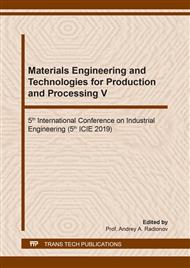[1]
L.G. Korshunov, Testing of metals on wear resistance at friction, in: M.L. Bernshtejn, A.G. Rahshtadt (Eds.), Physical metallurgy and heat treatment of steels, Metallurgia, Moscow, 1991, pp.387-413.
Google Scholar
[2]
Т.Е. Norman et al., Austenite Manganese Steels, Alloys Metals Review, 9(99) (1961) 2-11.
Google Scholar
[3]
M.A. Filippov, V.S. Litvinov, Ju.R. Nemirovskij, Steels with metastable austenite, Metallurgia, Moscow, (1988).
Google Scholar
[4]
N.G. Davydov, V.V. Sitnov, Properties, production and use of high manganese steel, Mashinostroenie, Moscow, (1996).
Google Scholar
[5]
M.A. Filippov, A.A. Filippenkov, G.N. Plotnikov, Wear resistant steels for castings, USTU-UPI, Ekaterinburg, (2009).
Google Scholar
[6]
GOST 9013-59 Metals. Methods for measuring Rockwell hardness, Moscow, State Standard. (1959).
Google Scholar
[7]
GOST 23677-79 Hardness Testers for Metals. General technical requirements, Moscow, State Standard. (1979).
Google Scholar
[8]
GOST 9450-76 Measurement of microhardness by indentation of diamond tips, Moscow, State Standard. (1976).
Google Scholar
[9]
V.S. Zolotorevskij, Mechanical properties of metals, Metallurgia, Moscow, (1983).
Google Scholar
[10]
V.M. Schastlivtsev, M.A. Filippov, The role of the austenite metastability principle of Bogachev – Mints when choosing wear-resistant materials, Metallurgy and heat treatment of metals. 1 (2005) 6-9.
DOI: 10.1007/s11041-005-0020-8
Google Scholar
[11]
L.G. Odintsov, Hardening and finishing of parts by surface plastic deformation, Mechanical Engineering, Moscow, (1987).
Google Scholar
[12]
I.N. Bogachev, Cavitation destruction and cavitation resistant steels, Metallurgy, Moscow, (1972).
Google Scholar
[13]
M.A. Filippov, A.A. Rudakov, The role of metastable austenite in ensuring the wear resistance and fatigue strength of metal alloys, in V.D. Sadowski (Eds.), The development of ideas of academician, IMF URO RAS, Yekaterinburg, 2008, pp.311-329.
Google Scholar
[14]
L.I. Pogodaev, Yu.N. Tsvetkov, Structural and energy criterion of wear resistance of metals and alloys, taking into account the rigidity of the stressed state of the surface, Problems of mechanical engineering and reliability of materials. 6 (1997) 40-52.
Google Scholar
[15]
A.Vinogradov, A.Lazarev, М.Linderov, A.Weinder, H.Biermann, Kinetics of deformation processes in high-alloyed cast transformation-induced plasticity steels determined by acoustic emission and scanning electron microscopy influence of austenite stability on deformation mechanisms, Acta Materialia. 61(7) (2001) 2434-2449.
DOI: 10.1016/j.actamat.2013.01.016
Google Scholar


